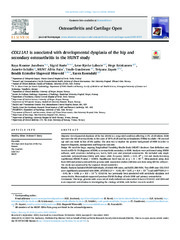Blar i forfatter "Thomas, Laurent Francois"
-
COL11A1 is associated with developmental dysplasia of the hip and secondary osteoarthritis in the HUNT study
Jacobsen, Kaya Kvarme; Børte, Sigrid; Laborie, Lene Bjerke; Kristiansen, Hege; Schäfer, Annette; Gundersen, Trude; Zayats, Tetyana; Winsvold, Bendik Kristoffer Slagsvold; Martinsen, Amy; Skogholt, Anne Heidi; Brumpton, Ben Michael; Willer, Cristen J; Fors, Egil Andreas; Kristoffersen, Espen Saxhaug; Heuch, Ingrid; Mundal, Ingunn Pernille; Zwart, John Anker Henrik; Nielsen, Jonas B.; Storheim, Kjersti; Hagen, Knut; Nilsen, Kristian Bernhard; Hveem, Kristian; Fritsche, Lars G; Thomas, Laurent Francois; Pedersen, Linda Margareth; Gabrielsen, Maiken Elvestad; Lie, Marie U.; Stensland, Synne; Zhou, Wei; Rosendahl, Karen (Journal article; Tidsskriftartikkel; Peer reviewed, 2023-12-16)Objective: Developmental dysplasia of the hip (DDH) is a congenital condition affecting 2-3% of all infants. DDH increases the risk of osteoarthritis, is the cause of 30% of all total hip arthroplasties (THAs) in adults <40 years of age and can result in loss of life quality. Our aim was to explore the genetic background of DDH in order to improve diagnosis, management and longterm outcome.<p><p> ... -
Exploring Interaction between Genetically Predicted Body Mass Index and Serum 25-Hydroxyvitamin D Levels on the Odds for Psoriasis in UK Biobank and the HUNT Study: A Factorial Mendelian Randomization Study
Jenssen, Marita; Arora, Nikhil; Løset, Mari; Åsvold, Bjørn Olav; Thomas, Laurent Francois; VAssmyr, Ole-Jørgen Bekkevold; Mai, Xiao-Mei; Sun, Yi-Qian; Furberg, Anne-Sofie; Jorde, Rolf; Wilsgaard, Tom; Danielsen, Kjersti; Brumpton, Ben Michael (Journal article; Tidsskriftartikkel, 2025-12-03)Mendelian randomisation (MR) studies show that higher body mass index (BMI) and lower 25-hydroxyvitamin D (25[OH]D) increase psoriasis risk. The combined effect of these factors has not been explored using factorial MR. Using cross-sectional data from UK Biobank (UKB, n=398 404) and the Trøndelag Health Study (HUNT, n=86 648), we calculated polygenic risk scores for BMI and 25(OH)D to estimate odds ... -
A genome-wide association study provides insights into the genetic etiology of 57 essential and non-essential trace elements in humans
Moksnes, Marta Riise; Hansen, Ailin Falkmo; Wolford, Brooke; Thomas, Laurent Francois; Rasheed, Humaira; Simic, Anica; Bhatta, Laxmi; Brantsæter, Anne Lise; Surakka, Ida; Zhou, Wei; Magnus, Per Minor; Njølstad, Pål Rasmus; Andreassen, Ole; Syversen, Tore; Zheng, Jie; Fritsche, Lars; Evans, David M.; Warrington, Nicole Maree; Nøst, Therese Haugdahl; Åsvold, Bjørn Olav; Flaten, Trond Peder; Willer, Cristen J.; Hveem, Kristian; Brumpton, Ben Michael (Journal article; Tidsskriftartikkel; Peer reviewed, 2024-04-09)Trace elements are important for human health but may exert toxic or adverse effects. Mechanisms of uptake, distribution, metabolism, and excretion are partly under genetic control but have not yet been extensively mapped. Here we report a comprehensive multi-element genome-wide association study of 57 essential and non-essential trace elements. We perform genome-wide association meta-analyses of ...


 English
English norsk
norsk

